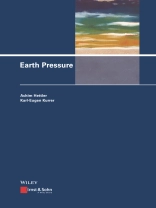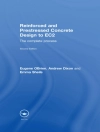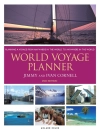The subject of earth pressure is one of the oldest and most extensive chapters in soil mechanics and foundation engineering and is one of the pillars of structural engineering. First the development of earth pressure theory is comprehensively described. The descriptions range from the first approaches to the determination of earth pressure through continuum mechanical earth pressure models to the integration of earth pressure research into the disciplinary structure of geotechnics.
The main part of the book comprises a selection of current calculation basics. The aim is to provide a collection of working instructions for foundation and structural engineers in construction companies, consultants and in building supervision as well as students. In order to further theoretical understanding, the essential basics of the determination of earth pressure are first presented. Then the most important processes for active and passive earth pressure and at-rest earth pressure for practical application are dealt with, with spatial effects also being taken into account. The book sets out to provide brief information about rarely encountered questions with references to further literature. In recent years, the dependency of earth pressure on displacement has been paid ever more attention. This applies not just to the passive but also to the active case.
Questions are repeatedly passed to the DIN committee ‘calculation processes’. A selection of these is dealt with in the commentary to DIN 4085, which came out in September 2018.
The history of earth pressure theory is supplemented by 40 selected short biographies of scientists and practical engineers, who have taken up the subject and further developed it over the years. The book also has two appendices with terms, formula symbols and indices as well as earth pressure tables.
قائمة المحتويات
1 Introduction 1
References 2
2 The history of earth pressure theory 3
2.1 Retaining walls for fortifications 5
2.2 Earth pressure theory as an object of military engineering 9
2.2.1 In the beginning there was the inclined plane 10
2.2.2 From inclined plane to wedge theory 20
2.2.3 Charles Augustin Coulomb 23
2.2.4 A magazine for engineering officers 34
2.3 Modifications to Coulomb earth pressure theory 36
2.3.1 The trigonometrisation of earth pressure theory 36
2.3.2 The geometric way 44
2.4 The contribution of continuum mechanics 54
2.4.1 The hydrostatic earth pressure model 56
2.4.2 The new earth pressure theory 58
2.5 Earth pressure theory from 1875 to 1900 67
2.5.1 Coulomb or Rankine? 68
2.5.2 Earth pressure theory in the form of masonry arch theory 69
2.5.3 Earth pressure theory à la française 71
2.5.4 Kötter’s mathematical earth pressure theory 75
2.6 Experimental earth pressure research 78
2.6.1 The precursors of experimental earth pressure research 78
2.6.2 Earth pressure tests at the testing institute for the statics of structures at Berlin Technical University 81
2.6.3 The merry-go-round of discussions of errors 85
2.6.4 The emergence of soil mechanics 87
2.7 Earth pressure theory in the discipline-formation period of geotechnical engineering 93
2.7.1 Terzaghi 96
2.7.2 Rendulic 99
2.7.3 Ohde 100
2.7.4 Errors and confusion 101
2.7.5 A hasty reaction in print 103
2.7.6 Foundations + soil mechanics = geotechnical engineering 103
2.8 Earth pressure theory in the consolidation period of geotechnical engineering 109
2.8.1 New subdisciplines in geotechnical engineering 110
2.8.2 Determining earth pressure in practical theory of structures 111
2.9 Earth pressure theory in the integration period of geotechnical engineering 116
2.9.1 Computer-assisted earth pressure calculations 118
2.9.2 Geotechnical continuum models 119
2.9.3 The art of estimating 124
2.9.4 The history of geotechnical engineering as an object of construction history 125
References 128
3 Methods for the determination of earth pressure 145
3.1 Overview and bound methods 145
3.1.1 Overview of the methods 145
3.1.2 Upper and lower bounds 146
3.2 Kinematic mechanism methods for active earth pressure 147
3.3 Kinematic mechanism methods for passive earth pressure 150
3.4 Static stress field methods 154
3.4.1 Fundamentals 154
3.4.2 Rankine’s solution 155
3.4.3 Theory of Boussinesq/Résal/Caquot 156
3.4.4 Solution by Pregl/Sokolowski 157
3.4.5 Analysis of Goldscheider 157
3.4.6 Approach of Patki/Mandal/Dewaikar 158
3.5 Tests and measurements 159
3.5.1 Fundamentals and scaling laws 159
3.5.2 Evaluation of test results and application of scaling laws 163
3.5.3 Example: active earth pressure under plane strain conditions from soil self-weight 164
3.5.4 Example: passive earth pressure under plane strain conditions from soil self-weight 165
3.5.5 Example: spatial earth resistance in front of soldier piles 169
3.5.6 Example: spatial earth resistance in front of square anchor slabs 169
3.5.7 Further examples 170
3.6 Finite Element Method 172
3.6.1 General 172
3.6.2 Examples 174
References 189
4 Active earth pressure under plane strain conditions 195
4.1 Fundamental considerations 195
4.2 Soil self-weight, infinite uniformly distributed surcharges and cohesion 197
4.2.1 Vertical wall, level ground, horizontal earth pressure 198
4.2.2 Vertical wall, level ground, inclined earth pressure 198
4.2.3 General case 199
4.3 Cohesion, calculated tension and minimum earth pressure 199
4.3.1 Determination of the classic earth pressure 200
4.3.2 Minimum earth pressure in comparison with the resultant of earth pressure 201
4.3.3 Minimum earth pressure in comparison with the earth pressure ordinate 201
4.3.4 Minimum earth pressure and surcharges 202
4.4 Vertical line loads and strip loads 203
4.4.1 Introduction 203
4.4.2 Standard slip surface from soil self-weight 204
4.4.3 Analysis of any slip surface angle 206
4.5 Horizontal line and strip loads 208
4.6 Layered soil 209
4.7 Discontinuous ground level 210
4.8 Discontinuous wall surfaces 212
4.9 Distribution of active earth pressure 212
References 213
5 At-rest earth pressure 215
5.1 Soil self-weight and infinite uniformly distributed surcharges 215
5.1.1 Horizontal ground 215
5.1.2 Inclined ground 217
5.2 Concentrated loads, line loads and strip loads 219
References 223
6 Passive earth pressure under plane strain conditions 225
6.1 Fundamental considerations 225
6.2 Soil self-weight, infinite uniformly distributed surcharges and cohesion with parallel movement 227
6.2.1 Straight slip surfaces 227
6.2.2 Pregl/Sokolowski 229
6.2.3 Comparison 230
6.3 Rotation about the top or the toe 231
6.4 Distribution of passive earth pressure 232
References 233
7 Spatial active earth pressure 235
7.1 Fundamental considerations 235
7.2 Cylindrical surfaces 237
7.3 Retaining wall across the slope 239
References 242
8 Spatial passive earth pressure 245
8.1 Overview 245
8.2 Passive earth pressure in front of soldier piles according to Weißenbach 245
8.3 Procedure according to DIN 4085 for limited wall sections 248
References 249
9 Influence of groundwater on earth pressure 251
9.1 Groundwater at rest 251
9.2 Flowing groundwater 251
9.3 Water pressure in tension crack 253
References 254
10 Compaction effects on earth pressure 255
References 257
11 L- and T-cantilever retaining walls 259
References 261
12 Silo pressure 263
References 264
13 Dynamic loading 265
References 266
14 Particular cases 267
14.1 Repeated quasi-static loading 267
14.2 Pipelines 269
14.3 Lateral pressure on piles 269
14.4 Creep pressure 270
14.5 Swelling pressure 270
14.6 Heavily fissured rock 270
14.7 Active earth pressure within dams 272
References 272
15 Mobilisation of earth pressure 275
15.1 Overview 275
15.2 Limit values of displacement on reaching the active earth pressure 275
15.3 Limit values of displacement on reaching the passive earth pressure 276
15.4 Mobilisation functions 276
15.4.1 Mobilised active earth pressure 276
15.4.2 Mobilised passive earth pressure 279
15.4.3 Spatial mobilised passive earth pressure 282
References 283
16 Application rules 285
16.1 Earth pressure inclination and angle of wall friction 285
16.2 Magnitude of earth pressure depending on the wall displacement 287
16.3 Earth pressure redistribution 289
16.4 Earth pressure as a favourable action 291
References 292
17 Commentary on DIN 4085:2017-08 293
17.1 Overview 293
17.2 Active earth pressure 293
17.3 Passive earth pressure 295
17.4 Earth pressure due to compaction 295
17.5 Spatial earth pressure 296
17.6 Advices on supplement DIN 4085:2018-12 296
References 297
18 Forty selected brief biographies 299
References 355
Appendix A Terms, symbols, indices 383
A1: Terms 383
A2: Symbols 384
A3: Indices 385
Appendix B Earth pressure tables 387
References 387
عن المؤلف
Univ.-Prof. Dr.-Ing. Achim Hettler was until 2018 head of the chair of soil mechanics and foundation engineering at the TU Dortmund. He is a member of standards committees and functions as the chairman of DIN 4085 ‘Subsoil: Calculation of earth pressure’ and chairman of the working group ‘Excavations’. Additionally, he is the author of the books Gründung von Hochbauten (foundations of buildings) and Baugruben (excavations), 2nd and 3rd editions.
Dr.-Ing. Dr.-Ing. E.h. Karl-Eugen Kurrer was editor in chief of the journals Stahlbau (1996-2018) and Steel Construction: Design and Research (2008-2018). Since 1996, Kurrer has chaired the working group on the history of technology at the VDI (Association of German Engineers) in Berlin. For more than 40 years, he has carried out research on the subject of history of civil engineering and in 2018 published the book The History of the Theory of Structures. Searching for Equilibrium, a standard work of the construction history.












